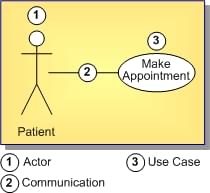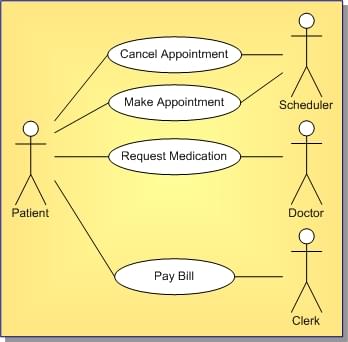UML 1.5 Use Case Diagram Definition
Go Up to UML 1.5 Use Case Diagrams
Contents
Use case diagrams are helpful in the following areas:
- Determining features (requirements) -- New use cases often generate new requirements as the system is analyzed and the design takes shape.
- Communicating with clients -- Notational simplicity makes use case diagrams a good way for developers to communicate with clients.
- Generating test cases -- The collection of scenarios for a use case may suggest a suite of test cases for those scenarios.
Definition
A use case is a description of a set of sequences of actions that a system performs to yield an observable result to an actor. A use case represents a functional requirement of your system as a whole. Use case diagrams describe what a system does from the viewpoint of an external observer. The emphasis is on what a system does rather than how.
Use case diagrams are closely connected to scenarios. A scenario is an example of what happens when someone interacts with the system.
Design a hierarchy of use cases:
- Usually, you begin at a high level and specify the main use cases of the system.
- Next, you determine the main system use cases at a more granular level. As an example, a
Conduct Businessuse case can have another level of detail that includes use cases such asEnter CustomersandEnter Sales. - Once you have achieved the desired level of granularity, it is useful to have a convenient method of expanding or contracting the use cases to grasp the scope and relationships of the system's use case views.
Sample Diagram
Following is a scenario for a medical clinic:
A patient calls the clinic to make an appointment for a yearly checkup. The receptionist finds the nearest empty time slot in the appointment book and schedules the appointment for that time slot.
A use case is a summary of scenarios for a single task or goal. An actor is who or what initiates the events involved in that task. Actors are simply roles that people or objects play. The following diagram is the Make Appointment use case for the medical clinic. The actor is a Patient. The connection between the actor and the use case is a communication association (or communication for short).
Actors are stick figures. Use cases are ovals. Communications are lines that link actors to use cases.
A use case diagram is a collection of actors, use cases, and their communications. Following is an example of the use case Make Appointment as the part of a diagram with four actors and four use cases. Notice that a single use case can have multiple actors.

